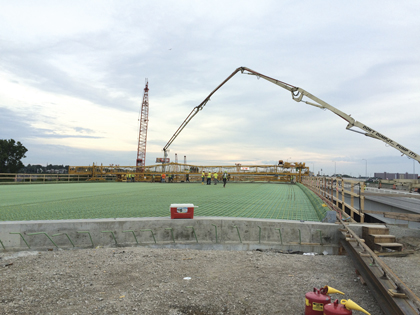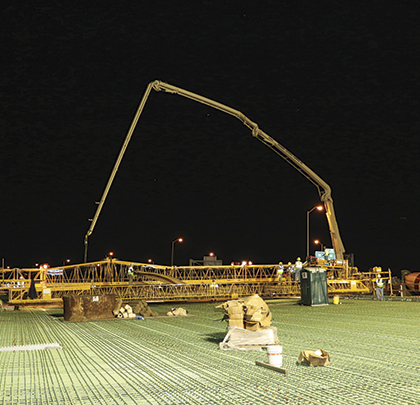The Ohio Department of Transportation (ODOT) is in the midst of a multi-year program to replace the functionally obsolete and structurally deficient Innerbelt Bridge crossing the CSX and Norfolk Southern railroad tracks, city streets, and Cuyahoga River in downtown Cleveland. The two new George V. Voinovich Bridges on Interstate 90 replacing the single 55-year-old structure will carry eastbound and westbound traffic through downtown and are just a part of the multibillion dollar Innerbelt Corridor revitalization program.
The more than half-billion dollar bridge investment has already seen completion of one, 4,347-foot-long bridge and demolition of the old Innerbelt Bridge. Construction has commenced on the second 3,918-foot-long twin structure and, when completed in 2016, will add lane capacity to more efficiently and safely carry the 140,000 vehicles traveling through the downtown area every day.
A design-build method—constructed by a joint venture between construction giants Trumbull, Great Lakes and Ruhlin (TGR) and designed by URS Corporation—is being used to save time. TGR purchased a Terex® Bid-Well 4800 paver specifically for the project, and crews planned to use it in multiple ways to complete various project segments more efficiently to save time, labor, and paving days.
WEEKEND WARRIOR
TGR’s first planned project for the paver was flatwork paving a portion of East 9th Street in busy downtown Cleveland. “People often think of the 4800 paver as a bridge paver,” mentions Terex Bid-Well regional sales manager, Marty Bachey. “While it effectively paves bridges, it can also be equipped with an internal vibration system for efficiently paving roads, similar to what TGR planned.”
This small section of roadway carries three lanes of traffic and offers access to I-90 West. “The paving width for this project started at 50 feet wide and tapered to 24 feet wide,” offers superstructure superintendent for TGR, Fenton Moore.
The challenge of paving this 150-foot stretch of road was to complete the project, start to finish, over one weekend, so traffic had to be diverted to use alternate routes. TGR meticulously planned the project. Removal of the existing road and installation, grading, and compaction of subbase material was to be completed Friday night into Saturday morning. Paving with the 4800 paver of a medium-set, 24-hour-cure concrete would take place on Saturday. Finally, the crew would overlay the 9-inch concrete base with 3 inches of asphalt Monday morning before being reopened to traffic later that day.
For this portion of the project, TGR planned to equip the paver with 24-foot end segments to allow up to 21 feet variable width paving at the right and left segments. This would allow the crew to vary paving widths by up to 42 feet, offering more than enough capacity to meet the 25-foot taper on East 9th Street.
Since TGR was prepared to use the 4800 paver for this project, the three manholes in this stretch of road were placed at grade without the need to construct box-outs, saving prep and paving time. “The operator can just lift the spud vibrator from the platform, move the paving carriage across the manhole, and then reinsert the vibrators into the concrete,” comments Fenton.
The job was planned for early summer, but factors outside of TGR’s control significantly delayed the project. The Cleveland Cavaliers’ run into the NBA post-season saw home games taking place over the weekends, “and there was no way we would have been allowed to close East 9th Street with both home basketball and baseball games taking place over the weekend,” mentions Moore.
Second, the weather did not cooperate, as more than two-thirds of the days in June saw measurable rainfall. Weather-related issues continually pushed back paving dates to the end of June to pour the 180 cubic yards of medium-set ODOT 4,500 psi concrete. With a looming July start-date for critical bridge deck pouring, TGR officials made the decision to pull the 4800 paver from the East 9th Street project and subcontracted the flatwork paving to another contractor.

Featured Image: Paving went smoothly for the approach pours, and the 4800 paver’s end segment design easily accommodated TGR’s variable width paving needs for the project. Photo courtesy of Trumbull, Great Lakes and Ruhlin.
Above: TGR segmented deck placement into five deck pours for the east approach and 19 pours for the main spans to place the 15,000 yd3 of the ODOT Class QC2/QA concrete. Photo courtesy of Trumbull, Great Lakes and Ruhlin.
SPREADING THE LOAD
With street paving shifted over to the subcontractor, TGR focused its efforts solely on the July start to deck pouring with the 4800 paver for the $273 million eastbound traffic bridge. Placement width along the 3,918-foot-long bridge varies from 119 feet to 87 feet wide on the main viaduct spans, and “the east approach measures 87 feet to 114 feet wide,” mentions viaduct superintendent for TGR, Jeff Lawson, P.E.
To complete the paving and placement projects, TGR purchased 126 feet of machine frame for the 4800 paver. Two, 15-foot transition segments were included in the frame’s construction. These inserts help maintain machine structural rigidity and meet the bridge deck’s stringent, 0.125-inch per 10-foot length smoothness specification. “Our transition segments increase frame depth from 48 inches at the ends to 66 inches in the center to provide a solid frame when paving at extended widths for the paving carriage to travel,” adds Bachey.
In total, the bridge deck will require 15,000 cubic yards of an ODOT Class QC2/QA concrete with designed strength meeting 4,500 psi. Deck placement was segmented into five deck-pours for the east approach and 19 pours for the main spans. While the bridge piers are positioned at skews to the centerline, the pours are broken up to where all are placed radially, so Terex Bid-Well’s available skew bar kit for the paving carriage is not required for this project.
Most critical for deck placement is distribution of machine weight on the overhang brackets. To counteract machine weight deflecting the rail, TGR equipped its paver with the optional six-wheel bogie system instead of the machine’s standard four-wheel bogies. “The 4800 design begins with all welded construction for maximum frame strength with minimum weight to help prevent torsional deflection,” comments Bachey. “Using the six-wheel bogie system spreads machine weight over an 18-foot span, which is about 36 percent wider than the standard four bogies. This further aids contractors working in states like Ohio to meet stringent deflection specs.”
In mid-July, TGR’s crews began the first of five pours to pave the 908-foot east bridge approach, which encompasses four spans and requires 2,800 cubic yards of concrete. The initial pour called for variable width paving of more than 30 feet from start to finish. With the machine’s frame offering up to 42 feet of leg travel to provide on-the-fly width changes, “the 4800 accommodated the variable width paving without any issues,” says Lawson. Paving of the four bridge spans of the east approach went smoothly. ■
For More Information: For more information about the Terex® Bid-Well 4800 paver, visit www.terex.com.
_________________________________________________________________________
Modern Contractor Solutions – April 2016
Did you enjoy this article?
Subscribe to the FREE Digital Edition of Modern Contractor Solutions magazine.

Prepared for Anything


